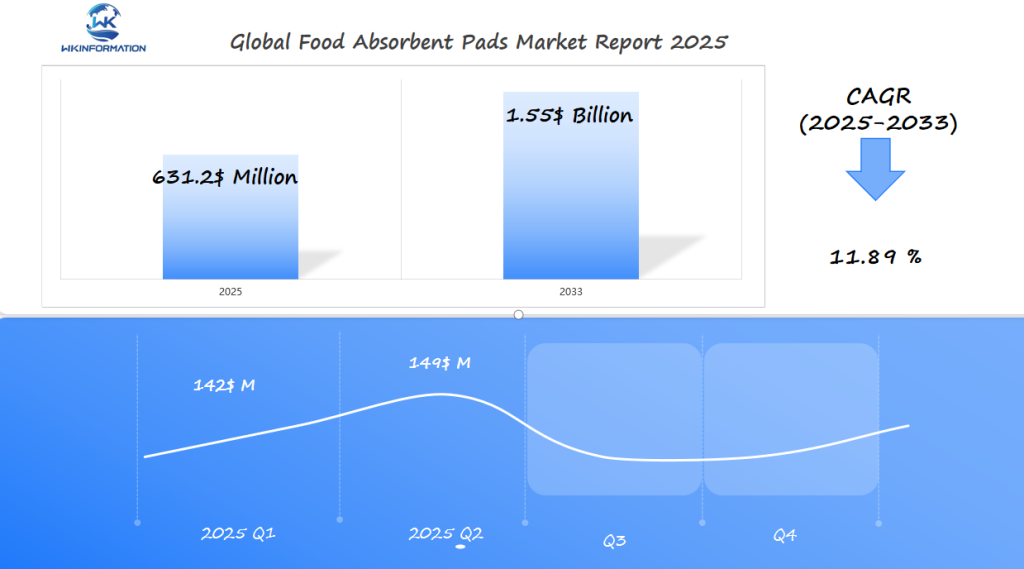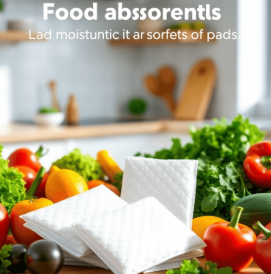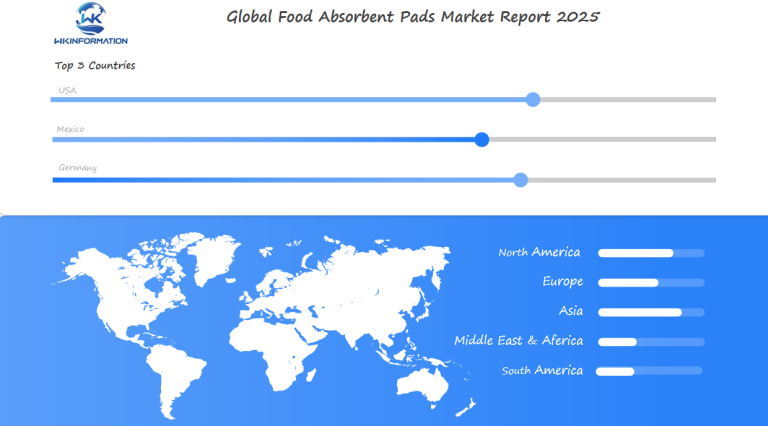Food Absorbent Pads Market in 2025 with $631.2 Million Insights and Growth Trends from the Germany, Mexico, and US
Explore the dynamic growth of the food absorbent pads market in Germany, Mexico, and the US, as these regions shape food safety and packaging innovations through 2025. Discover how Trump’s support for domestic production influences market trends, sustainability initiatives, and technological advancements in this essential industry.
- Last Updated:
Food Absorbent Pads Market Forecast for Q1 and Q2 of 2025
The global food absorbent pads market is valued at USD 631.2 million in 2025, growing at a CAGR of 11.89% from 2025 to 2033. In Q1 2025, the market is expected to generate approximately USD 142 million, driven by the growing demand in the food packaging and retail sectors. By Q2 2025, the market is projected to reach around USD 149 million, as the trend toward hygienic and convenient food packaging solutions continues to grow.
Germany, Mexico, and the US are key countries driving this market’s growth. Germany remains a leader in the European market due to stringent food safety regulations and increasing demand for sustainable packaging solutions. The US, with its large retail and food service industries, continues to be a major contributor to market growth. Mexico, with its expanding food processing industry and growing demand for packaged food, plays an important role in driving regional demand.

Upstream and Downstream Dynamics of the Food Absorbent Pads Market
The supply chain for food absorbent pads is influenced by various upstream dynamics, particularly in raw material sourcing. Factors such as the availability of cotton fibers, cellulose fibers, and polymers play a vital role in the production processes. These materials must be sourced sustainably while balancing cost efficiency to support market growth. Fluctuations in raw material prices can significantly impact manufacturing costs, affecting the final product pricing.
On the downstream side, distribution channels are shaped by evolving consumer demand. With increased awareness around food safety, there’s a growing expectation for products that ensure hygiene and prolong shelf life. Retailers and distributors have adapted by providing a range of absorbent pad options tailored to specific consumer needs. This shift is reflected in how absorbent pads are marketed and sold across different segments such as food packaging and healthcare.
Understanding these dynamics is crucial for stakeholders aiming to optimize both supply chain operations and customer satisfaction. As consumer preferences continue to evolve, companies must remain agile to navigate these complex upstream and downstream interactions effectively.
Key Trends Shaping the Food Absorbent Pads Market in 2025
Market trends predict significant changes in the food absorbent pads industry by 2025, mainly due to sustainability efforts and innovation. The industry is experiencing a rise in sustainability initiatives, with companies increasingly prioritizing reducing their environmental impact. This trend is evident through the creation of compostable materials that replace traditional plastics, aligning product offerings with eco-friendly practices.
Innovations in Food Absorbent Pads
Innovations in food absorbent pads highlight the shift towards more sustainable solutions. Manufacturers are experimenting with biodegradable components such as cellulose fibers and plant-based polymers to produce pads that are both effective and environmentally responsible. These developments are not only beneficial for the planet but also cater to a growing consumer base that values eco-conscious products.
Rising Consumer Awareness
Another crucial trend is the increasing awareness among consumers about the significance of food safety. As more people become knowledgeable about the health risks linked to improperly handled food products, there is a rising demand for high-quality absorbent pads. These pads play a crucial role in maintaining food hygiene by preventing spoilage caused by moisture, thereby ensuring longer shelf life and better quality retention.
The combination of sustainability-focused innovations and increased consumer awareness creates an opportunity for significant growth in the market, forcing companies to constantly adapt and innovate.
Market Challenges and Restrictions for Food Absorbent Pads
The Food Absorbent Pads Market faces several challenges that significantly impact manufacturers.
1. Fluctuation in Raw Material Prices
One major concern is the fluctuation in raw material prices, which directly affects production costs. Materials like cotton fibers, cellulose fibers, and polymers are subject to market volatility, forcing producers to balance cost-efficiency with quality.
2. Regulatory Restrictions
Regulatory restrictions also pose significant hurdles. Various materials commonly used in absorbent pad manufacturing are under strict regulations due to health and environmental considerations. These restrictions require constant adaptation and innovation within the industry to comply with evolving standards while maintaining product effectiveness, as highlighted in this study.
3. Environmental Concerns
Environmental concerns add another layer of complexity, particularly regarding the use of plastics. The global push towards sustainability means that manufacturers must explore alternative materials that align with environmental goals. This shift requires investment in research and development to create compostable or biodegradable options without compromising on functionality.
Challenges faced by food absorbent pad manufacturers require a strategic approach to navigate these obstacles effectively. The industry’s ability to adapt and innovate will determine its capacity to thrive amidst these constraints, setting the stage for future developments that align with both market demands and regulatory landscapes.
Moreover, looking ahead, it would be beneficial for manufacturers to stay informed about emerging trends in relevant industries, such as steel, which could influence the availability and pricing of certain raw materials used in the production of food absorbent pads.

Geopolitical Factors Affecting the Global Food Absorbent Pads Market
Geopolitical influences on food absorbent pad trade have become increasingly significant in shaping market dynamics. Tensions between countries can significantly disrupt the global supply chain for absorbent pads, leading to price fluctuations and uncertainties in the market.
1. Supply Chain Disruptions
Political instability or diplomatic conflicts can result in interruptions to raw material availability. This impacts manufacturers dependent on international suppliers, causing delays and increased costs.
2. Tariffs and Trade Agreements
Tariffs imposed by governments as a response to geopolitical tensions can alter pricing strategies for absorbent pad manufacturers. Trade agreements or restrictions influence sourcing decisions and cost structures.
3. Currency Fluctuations
International relations often affect currency stability. Fluctuations in exchange rates can complicate budgeting and forecasting for companies operating across borders, directly impacting their competitiveness.
These factors make it crucial for businesses within the absorbent pad industry to closely monitor geopolitical developments, adapting their strategies proactively to mitigate potential risks.
Segmentation Breakdown: Understanding Different Types of Food Absorbent Pads Available in the Market
The segmentation analysis of product types within the Food Absorbent Pads Market reveals a diverse range of options tailored to specific industry needs. Understanding these segments helps in identifying the best-suited pads for various applications.
Types of Food Absorbent Pads
1. Universal Absorbent Pads
These are designed to handle a wide array of liquids, making them versatile and suitable for multiple industries. In healthcare, they help manage spills and maintain hygiene, while in hospitality, they ensure cleanliness and safety by absorbing unwanted moisture from food or accidental spills.
2. Oil-Specific Variants
Targeted for environments dealing with oily substances, such as automotive or industrial sectors. They effectively absorb oils without absorbing water, providing an efficient solution for managing oil leaks and maintaining operational cleanliness.
Material Composition of Food Absorbent Pads
Absorbent pads are also categorized based on material composition:
- Plastic-Based Pads: Known for durability and resistance to tearing, though facing environmental scrutiny.
- Fiber-Based Options: Often used where compostability and eco-friendliness are prioritized.
Industries Benefiting from Food Absorbent Pads
Industries like food, healthcare, automotive, and chemicals find unique applications of these pads, each benefiting from their specific absorption capabilities. This segmentation insight allows businesses to align their purchase decisions with operational needs efficiently.
Global Trends and Regional Insights in the Food Absorbent Pads Market
The food absorbent pads market is experiencing significant growth, driven by increasing consumer demand for hygienic and extended shelf-life food packaging solutions. The market is also being shaped by advancements in absorbent pad technologies, sustainability concerns, and regulatory policies worldwide.
- North America and Europe lead the market due to stringent food safety regulations and the high adoption of packaged and processed food.
- Asia-Pacific is witnessing rapid expansion with the increasing consumption of ready-to-eat meals and frozen food products.
- Sustainability is a key trend, with manufacturers focusing on biodegradable and compostable materials to reduce environmental impact.
- Technological advancements, such as antimicrobial absorbent pads, are gaining traction, offering enhanced food safety and preservation.

U.S. Market Developments for Food Absorbent Pads
The U.S. market is one of the most developed in the food absorbent pads sector, driven by factors such as:
- Strict FDA regulations ensuring food safety and hygiene.
- Growing demand for convenience foods, including pre-packaged meat, seafood, and poultry.
- Expansion of online grocery and meal kit delivery services, increasing the need for advanced packaging solutions.
- Innovation in sustainable materials, with manufacturers investing in eco-friendly alternatives to traditional absorbent pads.
Mexico’s Role in the Food Absorbent Pads Market Growth
Mexico is emerging as a crucial player in the food absorbent pads market due to:
- Rapidly growing food processing industry, particularly in meat and seafood sectors.
- Rising exports of perishable food products, necessitating high-quality packaging solutions.
- Increased investment in food packaging technology to meet international standards.
- Government initiatives to improve food safety regulations, fostering demand for advanced absorbent pad solutions.
Germany’s Influence on the Food Absorbent Pads Market
Germany, a leader in sustainable packaging and food safety regulations, significantly influences the market:
- Strict EU food packaging laws driving the adoption of high-performance absorbent pads.
- Innovation in biodegradable and compostable pads, aligning with sustainability goals.
- Strong presence of major food processing companies, increasing the need for effective absorbent solutions.
- Emphasis on reducing food waste, prompting the development of moisture-absorbing pads that extend shelf life.
What’s Next for the Food Absorbent Pads Market?
The future of the food absorbent pads market is shaped by several key trends:
- Increased adoption of smart packaging solutions, integrating indicators for freshness and spoilage detection.
- Advancements in nanotechnology, improving absorption efficiency and antimicrobial properties.
- Expansion in developing regions, with rising demand for packaged food and improved cold chain logistics.
- Sustainability and recyclability focus, leading to the introduction of eco-friendly materials and compostable absorbent pads.
Competitive Landscape in the Food Absorbent Pads Market
-
Novipax – United States
-
AptarGroup, Inc. – United States
-
3M Company – United States
-
Pactiv Evergreen Inc. – United States
-
W. Dimer GmbH – Germany
-
Elliott Absorbent Products – United Kingdom
-
Cocopac Ltd – United Kingdom
-
Brady Worldwide, Inc. – United States
-
Sirane Ltd – United Kingdom
-
Cellcomb AB – Sweden
Overall
| Report Metric | Details |
|---|---|
| Report Name | Global Food Absorbent Pads Market Report |
| Base Year | 2024 |
| Segment by Type | · Polyethylene (PE) Absorbent Pads
· Superabsorbent Polymer (SAP) Absorbent Pads · Non-Woven Fabrics Absorbent Pads |
| Segment by Application | · Meat Food
· Fruits and Vegetables · Fish and Seafood |
| Geographies Covered | · North America (United States, Canada)
· Europe (Germany, France, UK, Italy, Russia) · Asia-Pacific (China, Japan, South Korea, Taiwan) · Southeast Asia (India) · Latin America (Mexico, Brazil) |
| Forecast units | USD million in value |
| Report coverage | Revenue and volume forecast, company share, competitive landscape, growth factors and trends |
The food absorbent pads market is poised for steady growth, driven by food safety concerns, sustainability trends, and technological innovations. While North America and Europe lead in regulations and sustainability efforts, emerging markets in Asia-Pacific and Latin America present significant growth opportunities. Companies focusing on advanced materials, biodegradable solutions, and smart packaging innovations will likely gain a competitive edge in the evolving market landscape.
Global Food Absorbent Pads Market Report (Can Read by Free sample) – Table of Contents
Chapter 1: Food Absorbent Pads Market Analysis Overview
- Competitive Forces Analysis (Porter’s Five Forces)
- Strategic Growth Assessment (Ansoff Matrix)
- Industry Value Chain Insights
- Regional Trends and Key Market Drivers
- Food Absorbent Pads Market Segmentation Overview
Chapter 2: Competitive Landscape
- Global Food Absorbent Pads players and Regional Insights
- Key Players and Market Share Analysis
- Sales Trends of Leading Companies
- Year-on-Year Performance Insights
- Competitive Strategies and Market Positioning
- Key Differentiators and Strategic Moves
Chapter 3: Food Absorbent Pads Market Segmentation Analysis
- Key Data and Visual Insights
- Trends, Growth Rates, and Drivers
- Segment Dynamics and Insights
- Detailed Market Analysis by Segment
Chapter 4: Regional Market Performance
- Consumer Trends by Region
- Historical Data and Growth Forecasts
- Regional Growth Factors
- Economic, Demographic, and Technological Impacts
- Challenges and Opportunities in Key Regions
- Regional Trends and Market Shifts
- Key Cities and High-Demand Areas
Chapter 5: Food Absorbent Pads Emerging and Untapped Markets
- Growth Potential in Secondary Regions
- Trends, Challenges, and Opportunities
Chapter 6: Product and Application Segmentation
- Product Types and Innovation Trends
- Application-Based Market Insights
Chapter 7: Food Absorbent Pads Consumer Insights
- Demographics and Buying Behaviors
- Target Audience Profiles
Chapter 8: Key Findings and Recommendations
- Summary of Food Absorbent Pads Market Insights
- Actionable Recommendations for Stakeholders

Access the study in MULTIPLEFORMATS
Didn’t find what you’re looking for?
TALK TO OUR ANALYST TEAM
Need something within your budget?
NO WORRIES! WE GOT YOU COVERED!
Call us on: +1-866-739-3133
Email: infor@wkinformation.com
What factors influence the supply chain of food absorbent pads?
Upstream factors affecting the supply chain include raw material sourcing for absorbent pads, while downstream factors involve distribution channels and consumer behavior regarding these products.
What are the key trends shaping the food absorbent pads market in 2025?
Key trends include increased sustainability initiatives within the industry, innovations in compostable materials for manufacturing absorbent pads, and a rise in consumer awareness about food safety.
What challenges do manufacturers face in the food absorbent pads market?
Manufacturers face challenges such as fluctuating raw material prices impacting production costs, regulatory restrictions on certain materials used in manufacturing, and environmental concerns related to plastic usage.
How do geopolitical factors affect the global food absorbent pads market?
Geopolitical tensions can disrupt the global supply chain for absorbent pads, leading to price fluctuations and uncertainties in pricing strategies across international markets.
What types of food absorbent pads are available in the market?
The market includes various segments such as universal absorbent pads and oil-specific variants, each with specific applications across industries like healthcare and hospitality.


